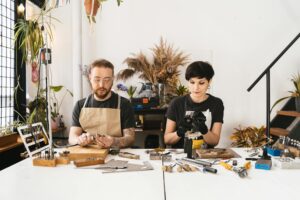Coding and makerspaces can definitely be a great addition to teaching STEM subjects. However, as an ESL/EAL instructor, there are very few ways for me to integrate coding and makerspaces into my lessons. Maybe I can’t support this blog post with many examples from my own teaching experience, but I would be glad to discuss the obstacles that are preventing me from using these technological advancements, and I will focus specifically on makerspaces.
What is a Makerspace?

That was the question I asked myself at the beginning of Ayodele and Chinazam’s comprehensive presentation. I was extremely excited to learn about the area of education that was fairly new to me. According to Michael Puckett (2021), the maker movement enables students to “create, ideate, invent and experiment while having fun learning through creative expression and technology” (Puckett, 2021). Maker’s spaces provide learners with an opportunity to access various equipment and tools, such as green rooms, digital cameras, and virtual reality devices, to explore, create, and collaborate. Makerspaces also support the principles of inclusion by creating a common place for sharing ideas and resources (Puckett, 2021).
Do All Learners Benefit From Makerspaces?
I believe that makerspaces are an absolutely fascinating way to make STEM subjects more fun and practical for students. As Ayodele and Chinazam mentioned in their presentation, some of the key beliefs associated with makerspaces are fostering active and contextual learning instead of the passive one. Puckett (2021) believes the maker movement encourages interdisciplinary STEM integration. Makerspaces also promote project-based learning, and, according to Jane Waite and Sue Sentence (2021), such an approach incorporates independence, realism, and ownership as learners have multiple options of what to work on and how to carry out their project.

Nevertheless, we should always remember that technology should be integrated to benefit our students. We should never introduce certain tools and devices to our students just because we want to keep up with the fast de
veloping world. We have to remember that makerspaces are created to primarily motivate STEM learners. My adult ESL students, on the other hand, need less equipment to learn successfully. We do use a lot of electronic devices in my class, such as a smart board, computers, a printer/copier, etc., but they are quite sufficient for my students to reach their goals of improving their English language skills. Moreover, some of my students lack technical skills, and working with elaborate equipment might actually discourage them. Although having access to VR glasses or robots from time to time might be an amusing change of pace for my students, I doubt we would resort to them too often because they may just be too complicated for them.
What Obstacles Are Holding Me Back From Organizing a Makerspace in My Classroom?
- Makerspace equipment is rather expensive. We have to admit that, unfortunately, the devices used in makerspaces are often quite costly. For example, Puckett (2021) states that a 3D printer may cost up to $1000. Unfortunately, not all organizations and educational institutions are able to afford such equipment, making organizing a makerspace an unattainable task. However, I am really grateful that my students have access to a computer lab, which helps them build essential digital skills while improving their English. Who knows, maybe one day we will have a small makerspace as well!
-

Photo by on Pexels Not all of my students possess sufficient technical skills. The levels of my students’ technical skills vary a lot. The computer-based tasks I prepare for my learners are pretty easy for some and quite confusing for others. Therefore, I feel that giving my students access to advanced makerspace equipment might actually cause frustration instead of excitement. I believe technology should be introduced gradually to ensure that everyone learns at their comfortable pace and benefits from the newly acquired knowledge.
- I would also need some training. I have just recently found out how to replace cartridges in a regular colour printer, and not without the help of my co-worker. That is why I think I would need much more training if we had a 3D printer or any other advanced tools! 🙂 We shouldn’t forget that before we introduce the makerspace to our students, we as educators should also familiarize ourselves with its equipment.
- We have to be mindful and realistic about our students’ goals. One of the main principles of Portfolio-Based Language Assessment (PBLA), the teaching model used in the Language Instruction for Newcomers to Canada (LINC) classes, is using real-world tasks to teach our students. While trying out robotics, VR, 3D printing, production equipment, etc. can be extremely beneficial for school and university students who are gaining skills for their future professions, my learners’ goals are a little different. They aim to build the basic language competencies that they can apply right away, such as reading food labels at a store or talking to a doctor. Encountering complicated devices offered in a makerspace may just not be my student’s short-term goal. Nonetheless, if makerspaces become more common, I would love to incorporate some VR technologies at least during one lesson a month to make my class even more engaging.
I am always open to new technologies, and I totally support such educational innovations as makerspaces. It is still a very new concept to me and many other educators, and it is still not adapted to every learner’s needs. Yet, if a makerspace ever becomes a part of my classroom, I will embrace that opportunity and do my best to use it for the benefit of my students.

Hello Kateryna, this is a very interesting blog post. True, I agree — as my teaching area is the social sciences, I believe too that I cannot exactly integrate Makerspace or coding in my subjects. I believe that it is too much of a learning curve for myself, and subjects like these are better taught by teachers in the technical fields, such as mathematics, computer science, or engineering. They will be able to appreciate it more in terms of instruction, unlike someone like me in the social sciences field. Thank you for this interesting post, I totally agree with your points here.
Kateryna, I liked your comments about learning the technology yourself and having realistic expectations. It can certainly be an overwhelming task for teachers to take on a whole new course such as Robotics, Computer Science, or to implement Maker Space kits effectively. It’s important teachers recognize this because if they choose to move forward without the pre-requisite knowledge the experience can be frustrating for student and they will become discourages and disinterested. Further to this, I think you correct in that the expectation need to be realistics and teachers shouldn’t put too much pressure on themselves to do this every period of every day.
Kateryna, your post is incredibly thoughtful and reflective! You’ve done an excellent job balancing the exciting possibilities of maker spaces with the realistic challenges you face as an ESL/EAL instructor. I appreciate your emphasis on aligning technology with students’ immediate goals, like improving language skills for daily life, is commendable and highlights your dedication to meeting your learners’ unique needs. I also appreciate your honesty about the need for teacher training and the varying technical skills among students.You are open to incorporating tools like VR in small, manageable ways and it shows your innovative spirit and willingness to embrace new opportunities .Good going,you will make a wonderful educator!
Good day Kateryna. Going into this section, I had zero experience with Makerspace as well. I was drawn to the section on obstacles to using this technology and totally agree. From what I saw in the presentation and the resources we had, I would say cost and needing training would also be my main reasons for shying away from it. I think however that developing the technical skill with most students could be done like with with most other skills we teach. It may take longer and need to be done in different ways, but for most, not impossible, Even me. LOL. Thank you for your thoughts and resources.
Hi Kateryna!!!
I really appreciate the way you emphasized on the makerspace and obstacles on the way of using this technology. It was completely new technology for me. So tried a learn bit more about this after going through your blog.
Keep the good work up!!!
Regards,
Gurjinder